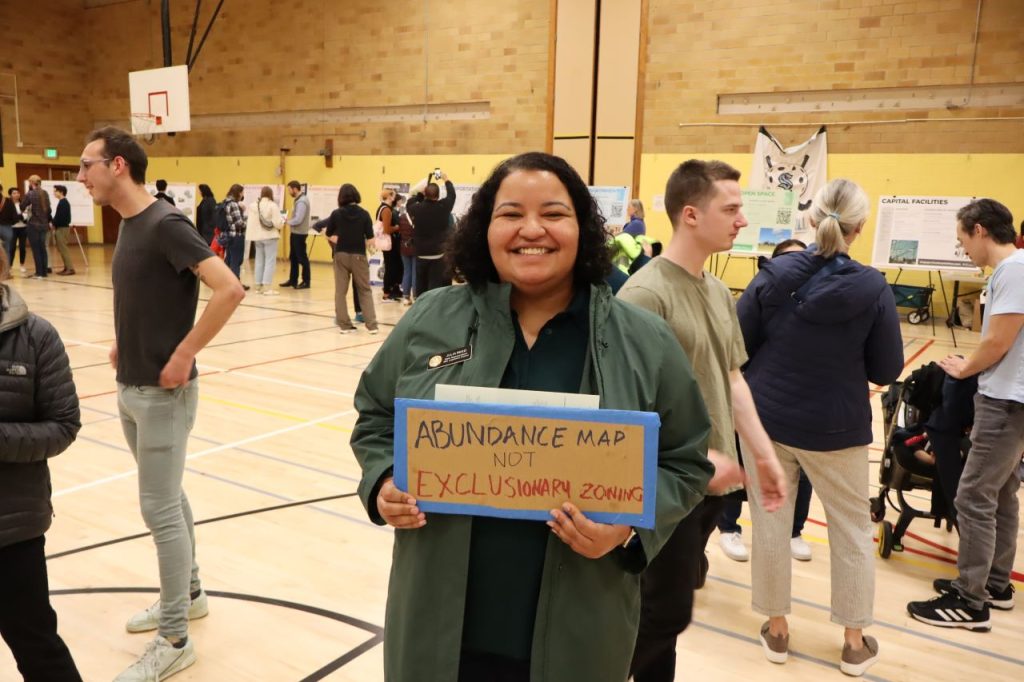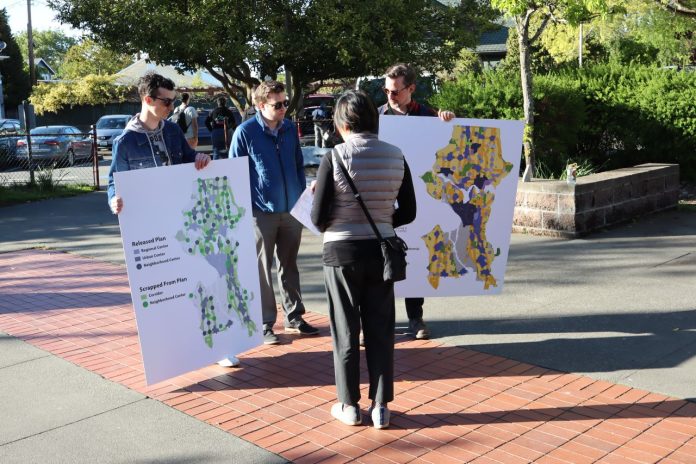
Advocates backed OPCD’s “housing abundance map” over Mayor Harrell’s more anemic draft proposal.
Seattle is in the midst of setting its 20-year growth strategy and the debate is heating up. Housing advocates held a rally to make the case for adopting “the housing abundance map” and increasing housing options citywide just before an open house that the City held on Tuesday April 30.
Members of pro-housing groups such as Seattle YIMBY and Seattle New Liberals brandished copies of the draft map that the Office of Planning and Community Development (OPCD) produced last summer before the Harrell Administration intervened and scaled back the plan in the fall, as The Urbanist was first to reveal last month.
Seattle YIMBY’s Sanders Lauture (who readers may recognize from his activism against motorists blocking bike lanes) said OPCD’s earlier housing abundance map — which included nearly 50 larger neighborhood centers instead of 24 smaller ones and five-story “Corridor” zoning within an eighth-mile of frequent transit — better reflected what Seattle residents want.
“Especially with the draft plan that was released by The Urbanist and PubliCola from the public disclosure requests, you saw the OPCD actually was listening back in early 2023, that they had a plan that was ready, that addressed some of the concerns that people were having about housing affordability,” Lauture said. “And the mayor’s office removed a lot of the additional housing options that were available across the city.”
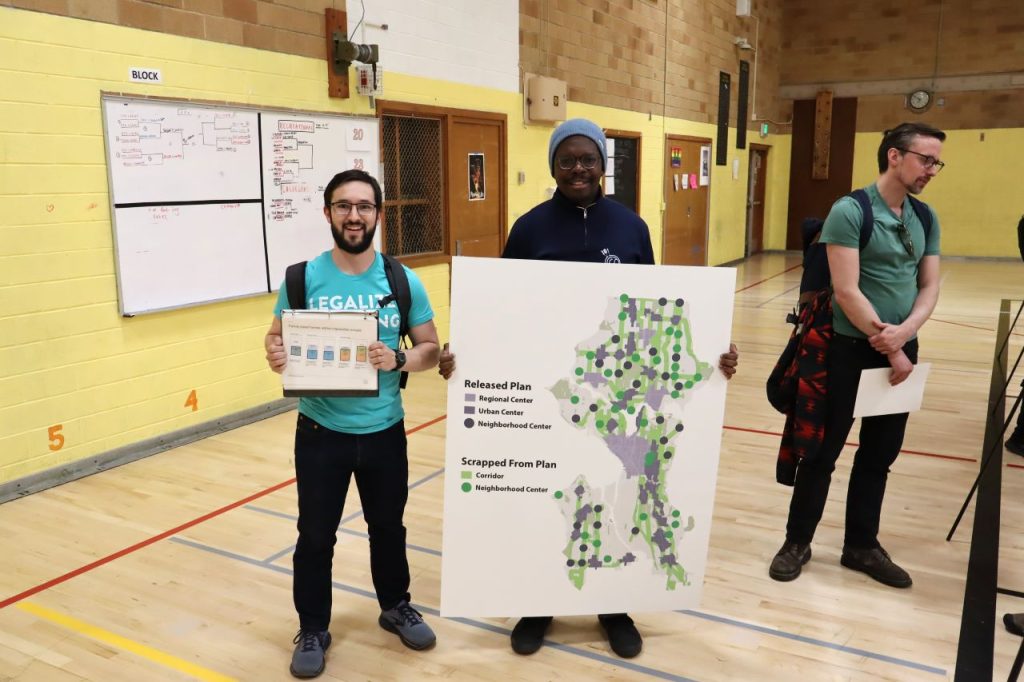
Housing advocates see the growth strategy, which is a part of the City’s Comprehensive Plan update, as an opportunity to boost housing opportunities by queuing up broad upzones. However, some neighborhood groups are pushing back and want the City to go it slow and continue to leave single-family neighborhoods largely off-limits to housing growth.
Those tensions came to a head at the OPCD open house at McClure Middle School in Queen Anne. The comment period on the Mayor’s draft Comprehensive Plan ends Monday May 20, and the event was OPCD’s last in-person open house. Organizers sought to make a final push for people to submit comments to OPCD with the hope of swaying policymakers, and they are optimistic that something closer to the “housing abundance map” is still on table.
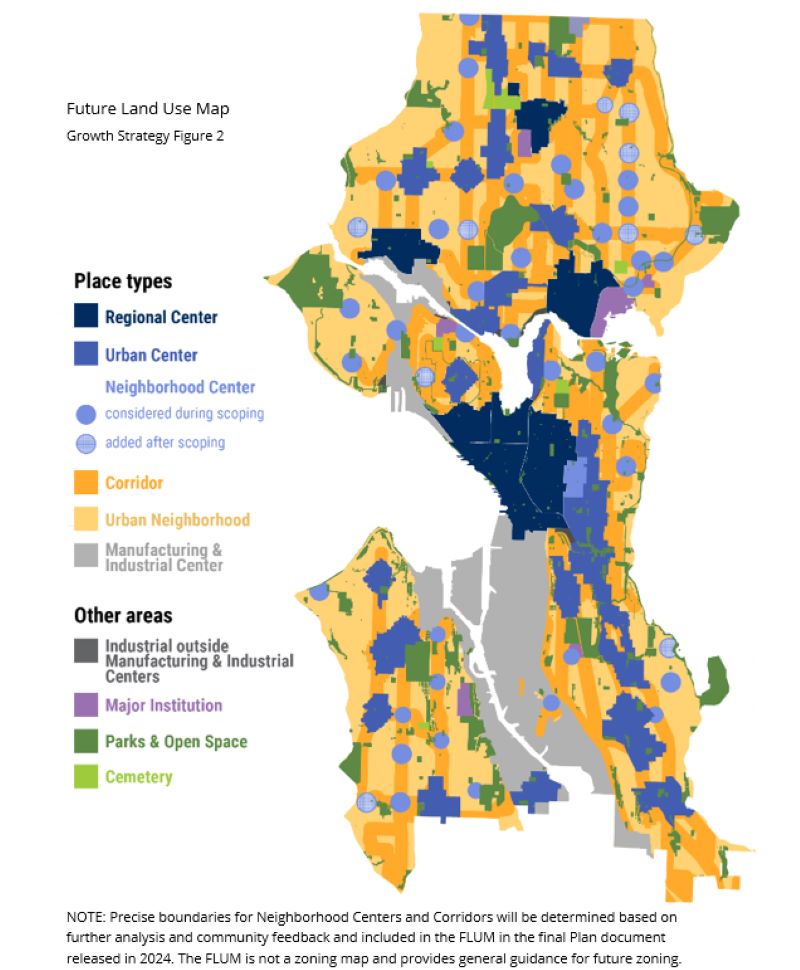
“So we know that OPCD is listening; we know that OPCD was willing to make the plan better for us, and we just need to make that heard,” Lauture said. “And this is the last chance we get. So I’m glad that everyone showed up. And I hope that OPCD listens, and I hope that the mayor finally listens as well.”
Attendance at the rally and open house also included State Representative Julia Reed (D-Seattle, 36th District), who lives partway down Queen Anne hill.
“I’m very much in support of having a bolder, bigger vision for housing in the city,” Reed told The Urbanist. “I mentioned at the rally that, we’re seeing plans coming out from Bellevue and Kirkland and Spokane that are like very visionary. And I personally think Seattle is the best city in the state, and I think we should have the best, boldest, most visionary plan for housing. And that’s really what I’m hearing from my constituents. So I’m just trying to help support that work.”
Reed is one of the main architects of statewide transit-oriented development (TOD) legislation — House Bill 2160 — that the state legislature has debated, but failed to pass the last two sessions. If passed, that legislation could still have an impact on Seattle’s zoning policy down the line, requiring cities to permit multi-story apartments near rapid transit stations. The state house did passed the TOD bill this spring, but the bill stalled in the senate.
“Transit-oriented development has a lot of support at the state level, and I would fully expect it to pass soon,” Reed said. “And that push is going to only continue; that momentum is behind it at the state level. So, I can’t promise that it’ll be the next session. But I hope that it will.”
The public records that The Urbanist obtained showed internal deliberations at OPCD, with the Mayor’s Office pushing for an option that only met rather than exceeded state requirements. With the failure of the TOD bill, that meant jettisoning broad zoning changes around transit stations in favor of lesser, fuzzier changes.
“Whether it’s next session or the session after, I don’t think we need to wait for the State to act,” Reed said. “You know, cities are always telling us that they understand their constituents best and that they don’t want to be overridden by the State. And so the State is really looking for cities to show that they are understanding the enormity of the housing crisis and are responding in kind. And, I think this works best when we have a collaboration between cities and the State, where the state can be filling in gaps and cities can be contributing their kind of unique pieces. And so I really hope that that will be continue to be kind of the tenor of this in the future.”
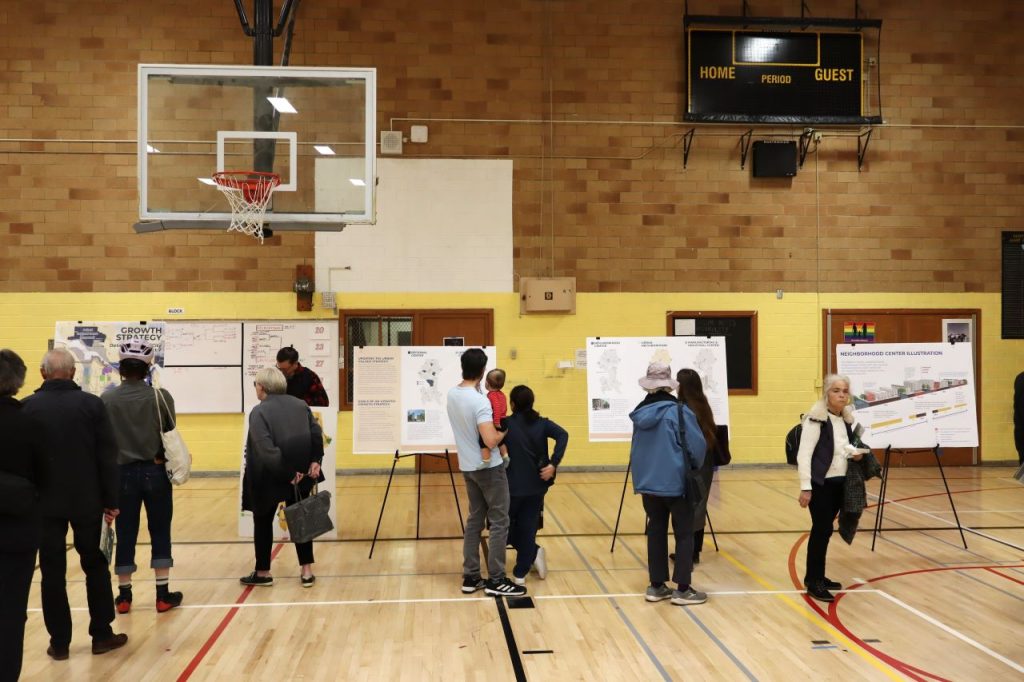
Advocates see the stakes as high, with people getting priced out of their neighborhoods, not finding housing that meets their needs, and being pushed out Seattle.
“Everyone wants more housing in their neighborhoods,” Lauture said. “They’re tired of housing prices going up. They want to have kids be able to live in the neighborhoods that they grew up in. They want to be able to have a family in an apartment that’s three [bedrooms] or more.”
Erik Nielsen, a member of Seattle New Liberals, said he held hope that the Seattle Council would intervene on the side of housing abundance, while acknowledging that a proposal to create a zoning incentive pilot program for affordable housing was soundly rejected by seven of nine councilmembers on Tuesday.
“It could not be more loud and clear about what the people of Seattle want, and I think if the Mayor’s Office isn’t going to do it, then I think the council will,” Nielsen told The Urbanist. “I know that there’s a lot of reason to be pessimistic, especially after today’s vote. But I really think that the messaging has been so clear and loud that by the time it gets to Council Chamber in a couple of months, they will have no other option but to be aggressive.”
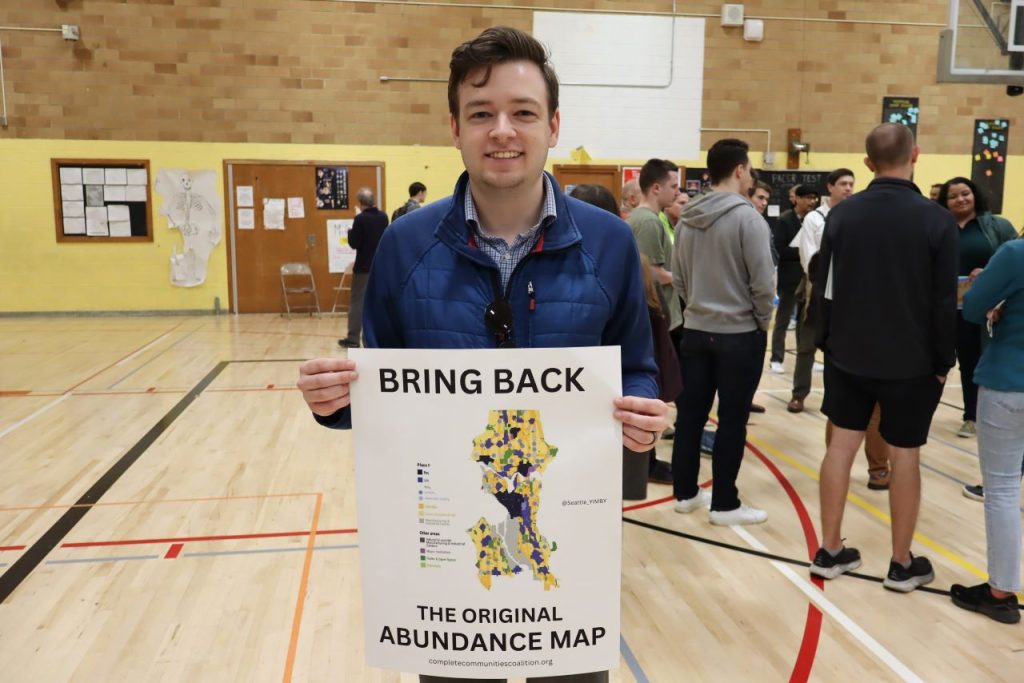
Nielsen pointed out that nearly every councilmember supported Alternative 5 or more, which was the boldest housing option that OPCD put on the table during the scoping period. Alternative 5 is also what OPCD mapped in the draft map that Harrell’s team overruled. Councilmembers Bob Kettle (District 7) and Maritza Rivera (District 4) were the exceptions who did not back Alternative 5 while campaigning last year, although Kettle (after skipping The Urbanist’s questionnaire and the ducking candidate forum dedicated to the comprehensive plan we co-hosted) did tell Crosscut he backed Alternative 5 on October 19 as ballots arrived.
Kettle’s history as a leader with the Queen Anne Community Council, which sued to block accessory dwelling unit reforms, suggests some innate skepticism despite those affirmations, but at a District 7 town hall nearby just a few days earlier, Kettle aligned himself with his colleagues. “I’m a comp plan 5 guy,” Kettle said.
“All of the community feedback from 2023 was leaning towards either Alternate 5 or more,” Nielsen said. “Almost every single city council candidate, whether they won or lost on the campaign trail in the fall was saying Alternative 5 or more. That was the resounding feedback. And so OPCD put together a plan that listened to that feedback, and it was completely overridden.”
Housing advocates are starting to see momentum after the Housing Affordability and Livability Agenda (HALA) fights under Mayor Ed Murray a decade ago and the Mandatory Housing Affordability (MHA) zoning fights under Mayor Jenny Durkan more recently stopped short of citywide changes toward the goal of housing abundance.
“I am glad that Seattle has become a city where this is even an option — that YIMBY and like urbanism is a thing,” Lauture said. “The work that The Urbanist has done and other groups have done over the last almost 10 years. Since 2016 when the last comp plan was finalized, the city has changed a lot. I remember reading articles — I wasn’t here yet — but I remember reading articles after I moved here about the HALA fight and the MHA fights and how the mayor’s office originally wanted a more abundant housing map. And they got shot down pretty much by most neighborhoods. But in eight years, the mood in the city has drastically changed. So I think this time around, we can do it. I think there’s a lot of appetite for making the city more affordable.”
Comment on the plan
Through May 20 at 5pm, OPCD is accepting public comment on the Comprehensive Plan via the online Engagement Hub or via email. You can also read the official letter submitted by the Seattle Planning Commission, which pushes the city to plan for more types of housing throughout the city.
Correction: The initial version incorrectly stated the McClure open house was on Wednesday. April 30 was in fact a Tuesday. Since the piece went to post, the draft plan comment period was extended by two weeks from May 6 to May 20. This article was also updated on May 7 to note that Kettle voiced support for Alternative 5 in October 2023.
Doug Trumm is publisher of The Urbanist. An Urbanist writer since 2015, he dreams of pedestrian streets, bus lanes, and a mass-timber building spree to end our housing crisis. He graduated from the Evans School of Public Policy and Governance at the University of Washington in 2019. He lives in Seattle's Fremont neighborhood and loves to explore the city by foot and by bike.

